@sleep-totem COOL! . . . . We want more!
Messages postés par Clint
-
RE: Anyma Phi first day demo videoposté dans Anyma Phi General
-
RE: Where to found more longer power cable ??posté dans Anyma Phi General
@ipi Sorry about that!
I'm a Sylphyo guy, and did not realize I was in the Anyma Phi corner of this forum ... "Never Mind" ...
-
RE: Where to found more longer power cable ??posté dans Anyma Phi General
@ipi This one is a bit longer (91cm): https://www.amazon.com/dp/B00P0GI68M
This is twice again as long: https://www.amazon.com/dp/B00NH11N5A
And this one is really really long: https://www.amazon.com/dp/B002KL8N6A/
Hope this helps ...
-
RE: Sylphyo Font Folioposté dans Sylphyo General
@armando-bersani My font package is a "work in progress" ... a nice way of saying it is incomplete. The clarinet fingerings (and most other instruments) have yet to be implemented. An initial version of sax fingerings is in the v1.008 release.
The idea of the font package is to allow you to easily type finger diagrams in documents, web pages, etc. Some people do use a text-based approach ... such as <xxxx|xooo ... where the "<" indicates the mouthpiece and the "|" indicates the split between the upper and lower hand. However, a vector-based font such as TrueType or OpenType is much more appealing.
The initial v1.008 of the Sylphyo fonts was a trial put out for testing and comments. And I have had many good comments, some of which suggest a re-design of the entire font package.
In particular, there was a suggestion to use the advanced features of OpenType to actually allow someone to type <xxxx|xooo ... and have the font itself provide a substitution which would allow applications (those that implement those advanced OpenType features) automatically change that <xxxx|xooo into a single finger diagram from the font. As it stands now, you have to locate the correct Unicode code point and enter it by hand, which is lot of work.
Another issue (for me) is how the Sylphyo fonts would be integrated with my existing font packages (see www.Kurinto.com and the Native Flute fonts at www.Flutopedia.com/fonts.htm).
There have been many other worthwhile suggestions (some of them above), the bulk of which expand the scope of this project (for me) significantly. I honestly have not had the impetus to undertake this larger project as we have been on the road for an extended trip (across Southern Europe - with the Sylphyo and a full recording rig - all worked beautifully!).
If people in this community are eager for this font project to move forward ... please make a note in this thread and it might provide encouragement for me to move forward with this project ...
-
RE: Sylphyo and Mainstageposté dans Sylphyo General
@peter-ostry Yes, uh, well, gee, it does seem that I made an early-on error in imaging what a Log curve is. I was thinking exactly the the opposite, and that may have led me down a long path ...
Here is a sample of the low-breath-pressure issue, played on Sylphyo via Link through the Patchman English Horn sample set, using Kontakt 6 and recorded in Cantabile:
https://ClintGoss.com/mp3/LowBreathPressureDemo.mp3
... The critical areas are in the areas (in seconds) of 1-2, 13-15, and 20-22. I initially believed that this "jittering" or "stuttering" was due to 7-bit MIDI, but then got up to speed with modulation curves.
The full discussion of the history of this is on the Native Instruments forum: https://www.native-instruments.com/forum/threads/high-resolution-breath-controller.442309/
So ... I may have to visit this and explore what kind of modulation curves would be suitable if I set the Sylphyo to Breath => Curve => Linear
-
RE: Sylphyo and Mainstageposté dans Sylphyo General
@peter-ostry said in Sylphyo and Mainstage:
If you use curves in your computer software, set the Sylphyo's breath curve to linear. Otherwise you never know who scales what.
One of the challenges I had when I started with the Sylphyo was volume control at very low breath pressures. Playing very softly (and corresponding large dynamic changes) is characteristic of the music traditions I was coming from (ethnic flutes) and I was getting noticeable jumps in volume coming from silent to pianissimo.
The Sylphyo can only produce low-resolution (7 bit) breath pressure MIDI commands. Aodyo is concerned that doubling the size of the MIDI command in order to produce high-resolution (14 bit) CC#2 will cause capacity issues (see https://community.aodyo.com/topic/545/support-for-high-resolution-midi/12).
I have compensated (successfully!) by using a combination of two breath curves:
-
My Sylphyo is set to Breath => Curve => Log, and
-
Many of the virtual instruments I use have breath response curves such as this one in Kontakt:

The "Table" version of that curve looks like this:

... which does exhibit (if you look carefully) a bit of the stepwise nature of 7-bit MIDI velocity curves.
Yes, these two curves (the Sylphyo and the Kontakt) are compounded together to produce the response curve I needed, but they do work quite well for me.
-
-
RE: Anyma Phi editor softwareposté dans Anyma Phi General
@origami23 said in Anyma Phi editor software:
made wit the Anyma Phi in the early users area
Can you point me to the "early users area"?
-
RE: Request; Save Sylphyo settingsposté dans Support
@paul-flute This would be a great feature, but I'm not exactly sure how to accomplish it (in terms of workflow) - Maybe some Sysex process?
I have thus far been maintaining a text document for my settings, but it is a messy affair. When I want to try out a setting - "Oh, maybe if I change this setting it will help this-or-that issue" and then I don't document it ... things can get complicated.
The need for this is strong for me, since I need to (very) occasionally execute a full reset on my Sylphyo. My self-maintained text document is my only reference to restore the state of my Sylphyo, and it would be a bit of a disaster if I could not restore it.
-
RE: Sylphyo and Mainstageposté dans Sylphyo General
@paul-flute Could you say which YouTube video are you referring to? This one ... https://www.youtube.com/watch?v=YdiqO-dJoRY ... is the top hit for "Eustache Sylphyo Mainstage" ... but I'm not sure that's the one.
In my limited experience so far, I have had to do some basic customization to most of the virtual instruments that I want to respond to CC messages such as those generated by the Sylphyo Elevation, Roll, and Compass (Pitch, Roll, and Yaw). This customization has been straightforward in the sound-rendering tools that I use: Kontakt, Reaktor, Cantabile, Respiro, and other plugins all have some straightforward way to map a given CC to a given control within their interface.
In particular, I have found Cantabile to be excellent with respect to managing the overall structure of a song (and a full set list), with all their attending instruments, effects, routes, interfaces, and recording requirements. One thing it does not really handle is live looping - I am currently using a physical looper for that.
However, some of the "MIDI Learn" functions that are straightforward for keyboard players are not so useful with the Sylphyo, since it is producing multiple CCs whenever you move the instrument. A few tools will display a choice of all the received CC messages when you initiate a "MIDI Learn", but it can be a challenge. I usually just type in the controller number and range.
Another challenge may be how to map the range of CC value to the desired behavior. Some CC values produced by the Sylphyo - elevation, for example - were not what I had imagined at first, and I had to sit down with the Sylphyo Bench application or run a MIDI monitor to explore what was actually being sent by the Sylphyo.
I have found that having a good command of the MIDI monitor tools in my system to be critical to diagnosing subtle playing issues. One or another virtual instrument might respond unexpectedly to the precise sequence of MIDI commands output by the Sylphyo, and the MIDI monitor tools come to the rescue (I have found this particularly true with physical modelling engines built by various folks in Reaktor 6).
-
RE: Moisture (Sylphyo problems with spurious notes and key change)posté dans Support
If I do not take precautions against moisture, I also get erratic behavior after playing a long time. This is probably because I am a "wet" player (I tend to have a lot of moisture).
One simple trick I use is to simply swallow once before putting the Sylphyo to my lips.
Of course, swabbing after playing helps. I first swab with two oboe cloths together, followed by another (a third) single cloth. I use these cloths: https://www.amazon.com/Hodge-Silk-Oboe-Swab-Blue/dp/B001M5CZR8
@Support_AODYO recommends storing the Sylphyo vertically after playing, and I find that does help. I am guessing it moves moisture down/South and away from the capacitive keys. My preferred setup for storage is a floor stand with a small fan. This is described in https://community.aodyo.com/topic/606/floor-stand/7.
However, this floor stand is not practical for me currently. We are on the road for 5 weeks now (across Europe from Portugal to Croatia). I've got all my stuff (Sylphyo gear and personal stuff) in a knapsack and a carry-on bag, so the floor stand is too bulky. I can't just stand my Sylphyo on end for fear of having it knocked over by hotel staff (or me!). So ...
On the road, I swab out my Sylphyo after playing, lay it down horizontally, and use a small USB fan to move air through the breath chamber. This is described in https://community.aodyo.com/topic/663/a-gentle-breeze.
This has worked well, and despite playing 1-2 hours a day, I have had no moisture issues.
-
RE: ventiler le Sylphyoposté dans Sylphyo General
@bernard-béville said in ventiler le Sylphyo:
and an 8-euro computer fan
Cool design!
Could you provide a source for the fan??
-
RE: rock plus roll on CC76?posté dans Sylphyo General
@ijfritz OK, I see now ... I was not looking at the second half of your video ...
So - maybe you are you actuating the "Compass" accelerometer? You are changing the lateral orientation of the Sylphyo ...
-
RE: rock plus roll on CC76?posté dans Sylphyo General
@ijfritz I think what you are doing is the "roll" motion.
-
RE: Floor Standposté dans Sylphyo General
@peter-ostry My thinking is that I want to create as dry an atmosphere inside the airway to counteract any possible humidity that might have accumulated outside the airway (i.e. in the electronics area).
I do swab the airway with three oboe cloths after I play. I think (and it appears on inspection) that, after I swab, there is no significant visible moisture. In any case, if there are tiny droplets of liquid remaining, it does not appear that they will "drip off" - they are tiny, and there is a significant bevel at the foot end of the airway that would catch (and retain) any tiny water droplets.
Yes, I do not think the 5° tilt is needed! However, it has an appealing feel and does maybe add a bit of safety.
One concern I have is that there is a noticeable metallic, electronics aroma from the mouth of the Sylphyo. It seems to vary in strength based on how much I play it. Have others experienced this??
Another concern is that the internal airway of my Sylphyo does not appear to be "sealed". If I block the bell port completely and breath gently through the mouthpiece, air freely escapes ... to ?someplace?. It is not escaping from around the mouthpiece, so it must be going someplace in the body of the instrument.
In any case, this is not a major issue ... yet. I am taking these steps to avoid a potential issue down the line.
-
RE: Floor Standposté dans Sylphyo General
I've developed a 3D-printed vertical stand for the Sylphyo. This was spurred by the suggestion (previously unknown to me) that the Sylphyo should be stored vertically (see https://community.aodyo.com/topic/663/a-gentle-breeze/6) to aid drying / drainage.
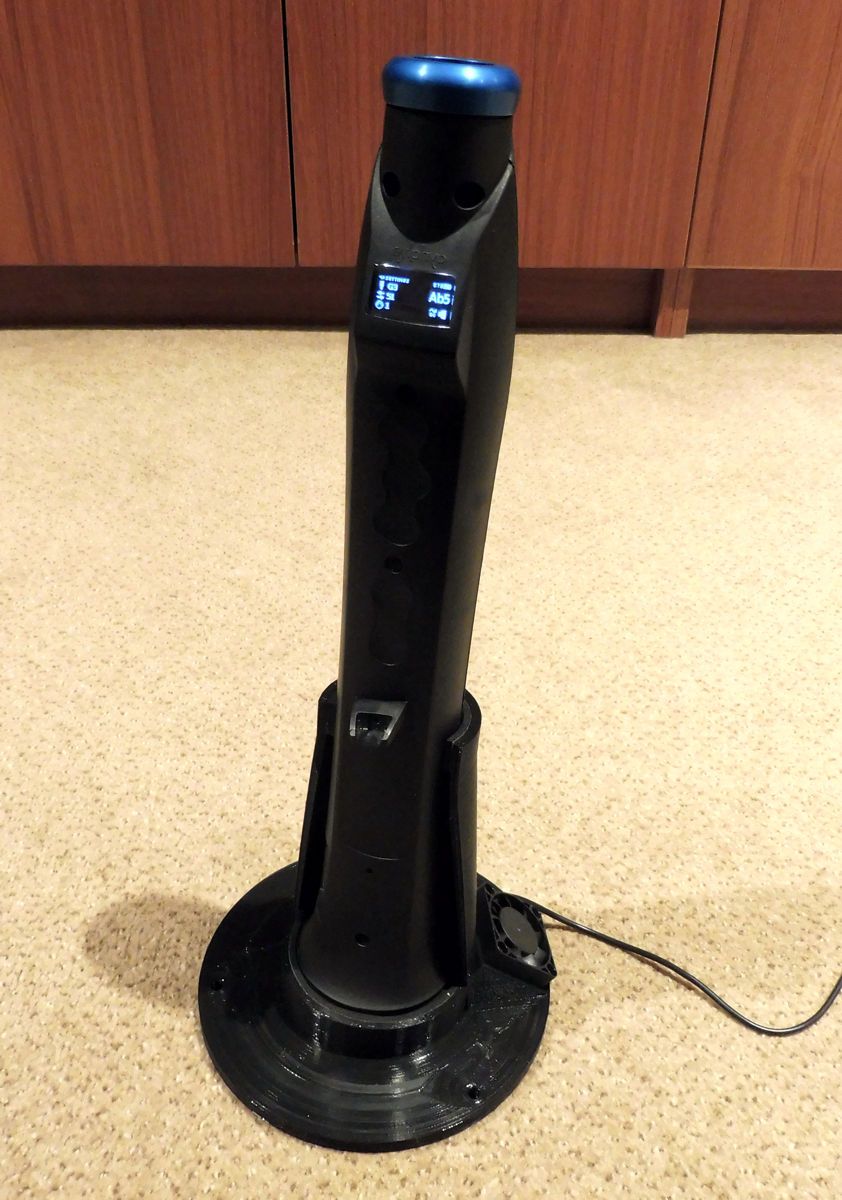
My design uses a 40 x 40 x 10 mm USB-powered fan to push (or pull) air through the instrument (https://www.amazon.com/dp/B0836QY8JC).
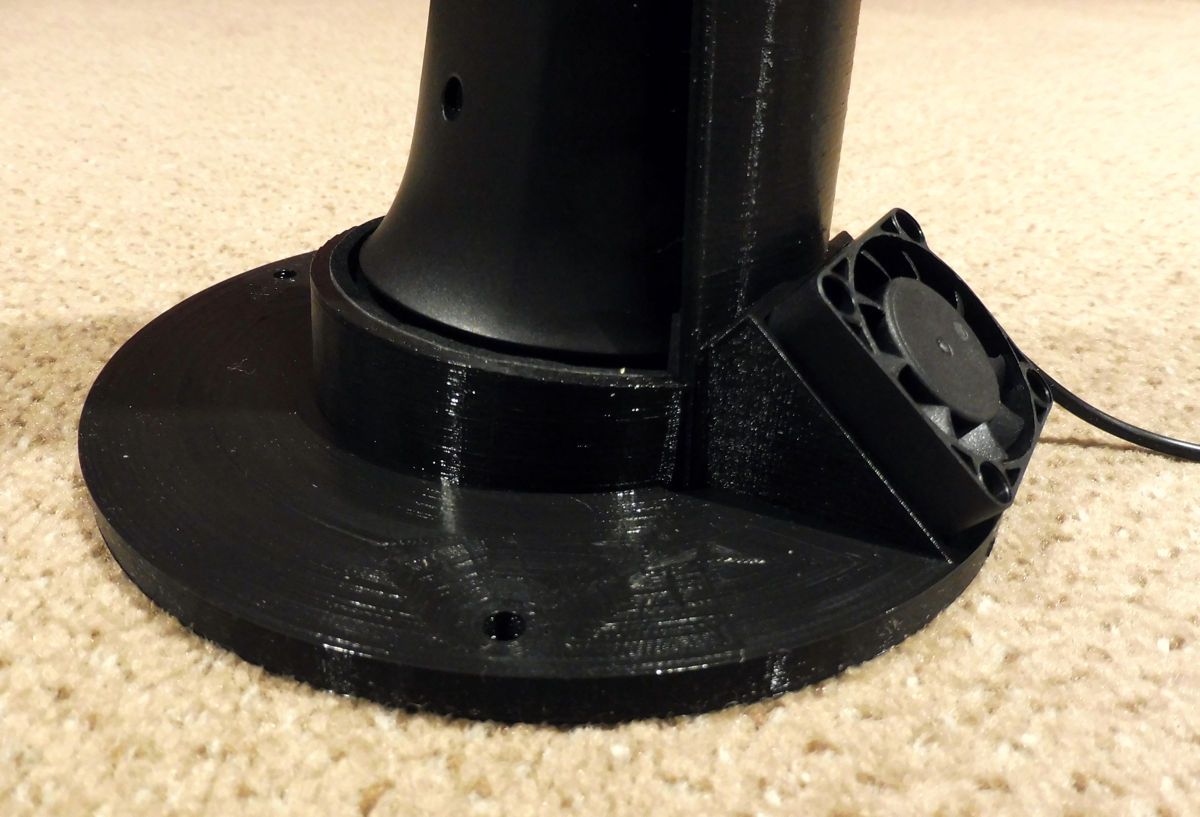
There is a "plumbing system" below the base that routes airflow from the fan on the side of the stand to the bell of the Sylphyo.
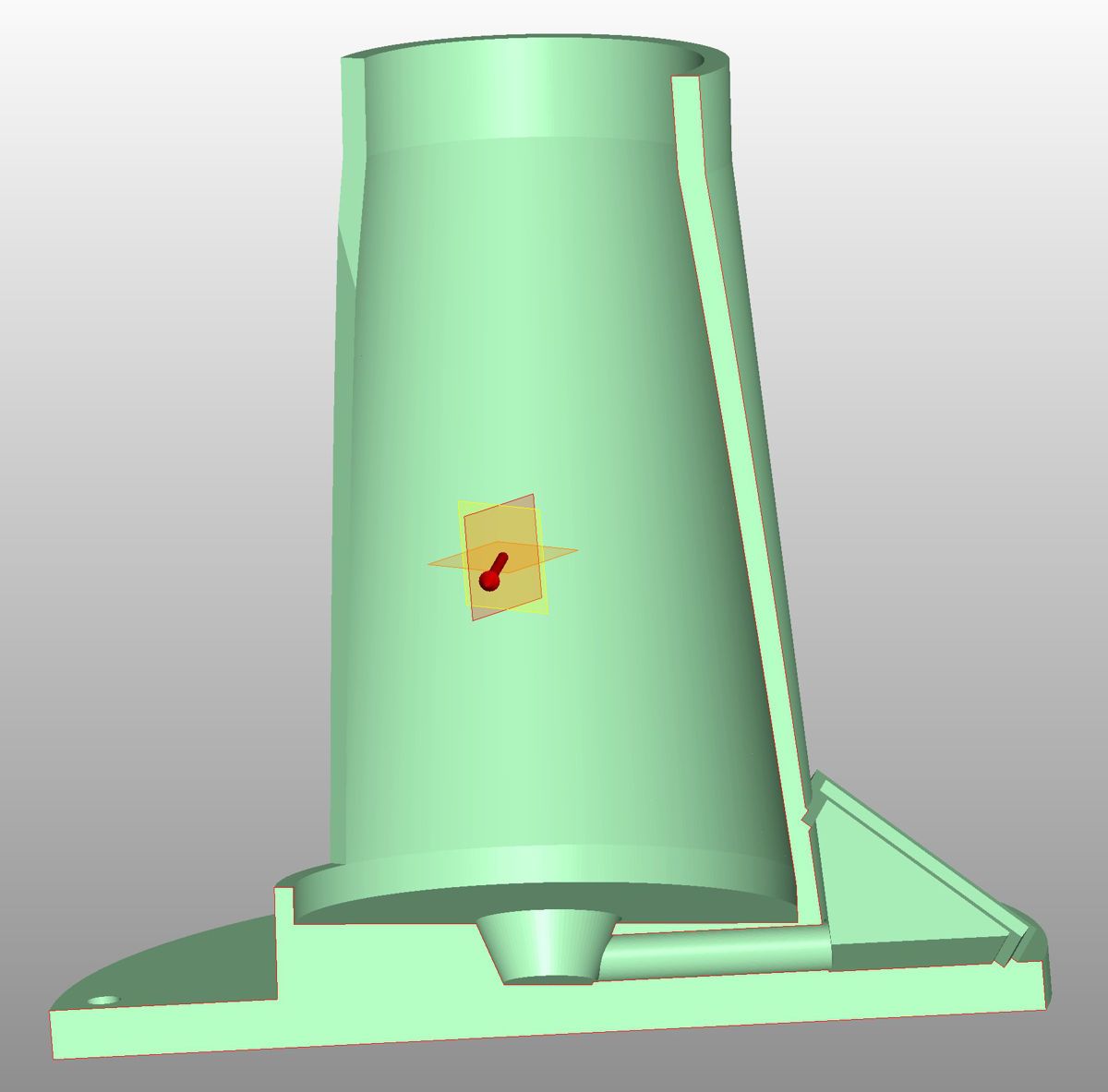
The stand keeps the Sylphyo at 5 degrees from vertical. I use self-stick 1/8" thick neoprene (https://www.amazon.com/dp/B008BFTOHQ) as cushions. The brace at the top is narrow enough (with the neoprene padding) to insert the Sylphyo turned sideways. Once you rotate the Sylphyo so that the thumb pads face forward, the width of the body keeps the Sylphyo from falling out. The floor platform is covered with Neoprene as well, which forms a reasonably tight air seal for the fan to gently move air through the instrument.
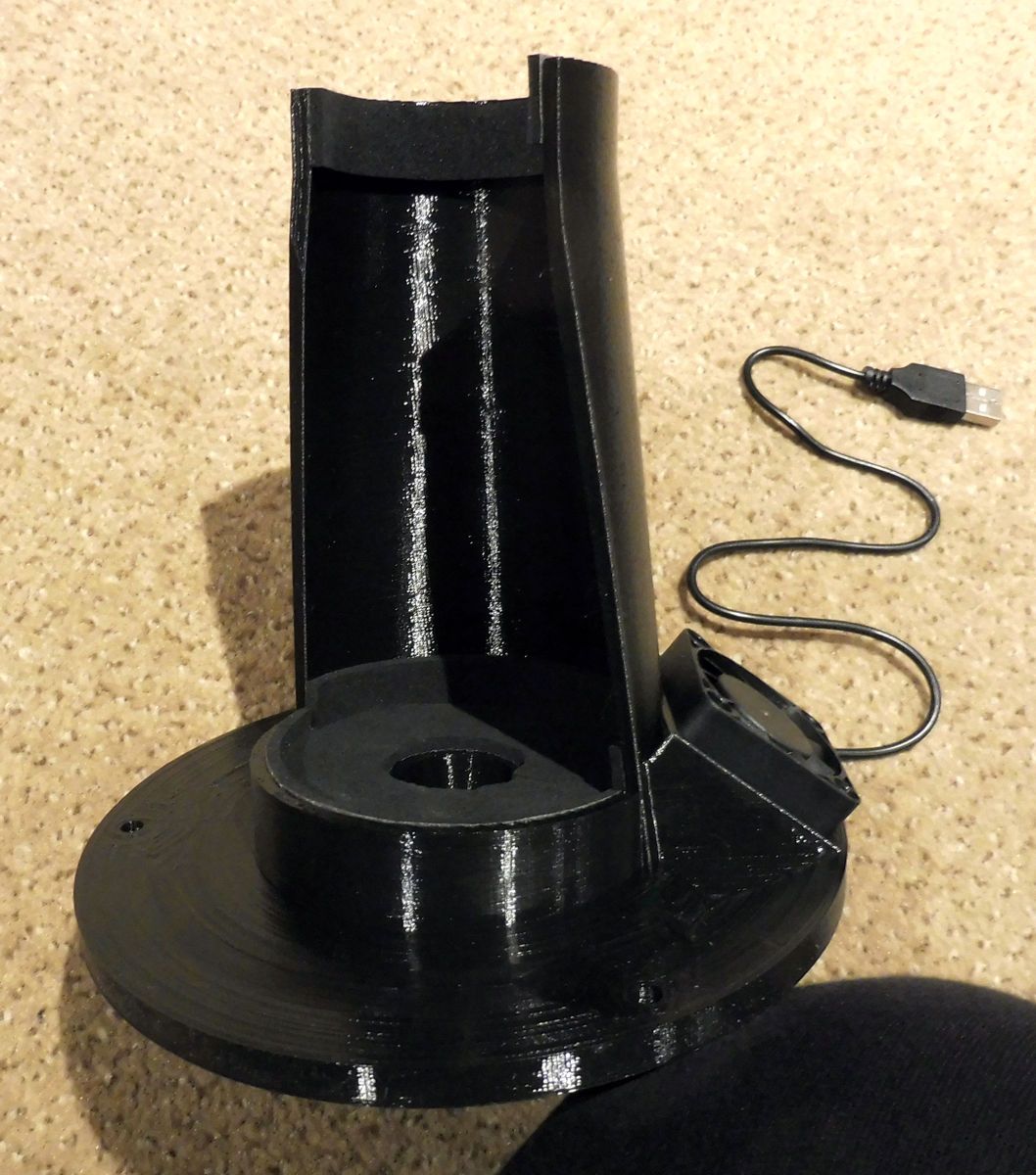
I have added three holes for 5M size bolts so that the stand can be fixed to a larger plate for stability. I will likely use wing-nuts for ease of assembly.
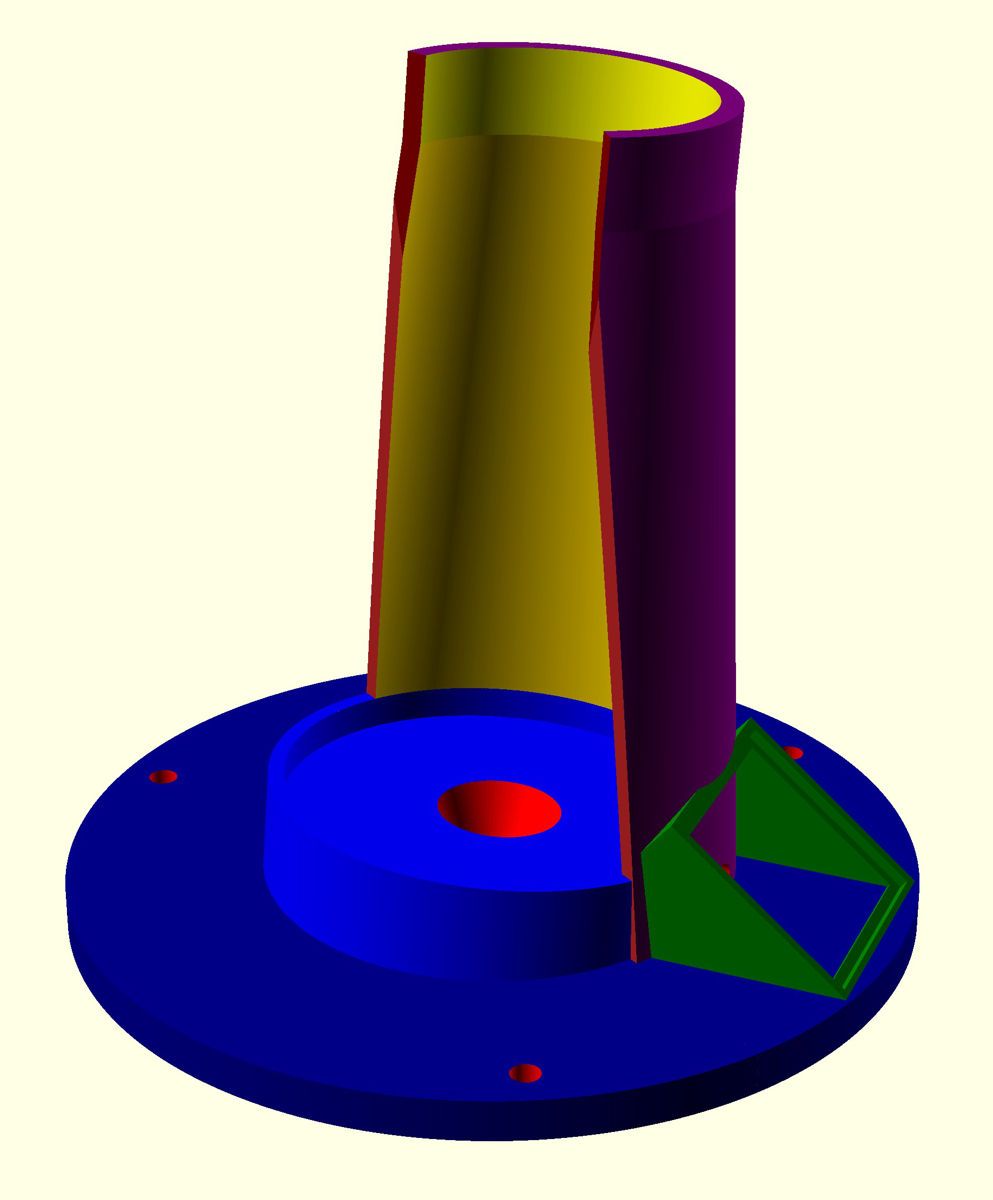
I am hoping that this stand will avoid any potential moisture issues. My experience has been that, after a lot of playing, some of the Sylphyo finger pads misbehave for a short while (30-60 seconds) when I start it up the next day. The pads that misbehave are the ones on the bottom side of the instrument when I store it horizontally. I am hoping that vertical storage will avoid these type of issues.
I would be happy to post this model as an STL file under an Open Source license (CC-BY) if anyone is interested ...
-
RE: Behavior of Elevation Controlposté dans Support
@peter-ostry Thanks for the clarification ... I had made some unfounded assumption as to how it was designed to work.
My main performance DAW is Cantabile, which has a massive set of MIDI filtering, mapping, and munging tools - I can massage pretty much any MIDI stream into what I want (Sysex excepted).
-
Behavior of Elevation Controlposté dans Support
I'm working with elevation in Kontakt and am getting (what appears to be) strange input from the Sylphyo:
My config parameters on the Sylphyo are:
* MIDI Mapping Elevation ctrl. CC 75 * Movement Elevation control: On Bidirectional: Off Absolute: Off Range: +- 35 degreesWhat I am seeing is:
- A linear increase in CC75 from 0 at straight down (let's call that 0 degrees) to 127 at horizontal (90 degrees).
- CC75 Steady at 127 as I continue up about another 20 degrees (up to 110 degrees)
- A linear decrease in CC75 as I continue further up from 110 degrees to about 160 degrees (20 degrees before straight up).
I am actually using elevation in the way the old Native Flute players used it (see below) ... but I would rather not go that high up ... I would really like 127 to be output at a most 35 degrees up rather than 90 degrees ...

-
RE: Feature Request: Turning PC out off.posté dans Support
@peter-ostry I was thinking that this would be controlled by:
* MIDI Mapping Program change > Send Bank Off... or maybe I am not understanding the purpose of this configuration parameter.
-
Minor Typo in Sylphyo Manualposté dans Support
Roll ctrl.
Set the MIDI CC sent when varying the elevation angle of the Sylphyo if the Roll control option is set in the Movement section.
Default: CC 76Probably should read: "roll angle" or "amount of roll"
-
RE: Blocking the Bell Portposté dans Sylphyo General
@clint I have just added a "User comment" to this effect on the Thingiverse plugs ...
-
RE: Blocking the Bell Portposté dans Sylphyo General
@support_aodyo said in Blocking the Bell Port:
SLS plastic, Nylon PA12 100-120μ (white)
So it looks like (from various on-line specs) that Nylon SLS materials are significantly more flexible and elastic than PLA. I am concerned that the plugs I printed in PLA from Aodyo's Thingiverse STL files might be stiff enough to damage the bell port of the Sylphyo.
Maybe a notation should be added to that Thingiverse posting to suggest that Nylon is preferable to PLA or ABS for that reason ...
-
RE: Question about "Always on" and "LED"posté dans Support
@peter-ostry On the LED setting: it is only for the Snow edition. Only that edition has a LED. I too was confused about this and asked a while back in https://community.aodyo.com/topic/546/led-setting/5
-
RE: Key reaction time 0 not usable?posté dans Support
I concur with @Peter-Ostry ... Key Reaction = 0 seems to require that Octave Reaction = 0.
-
RE: Key reaction time 0 not usable?posté dans Support
Here are my settings, with same issue as Peter ...
Clint's Configuration Settings for the Aodyo Sylphyo
Firmware version: 1.4.8
As of 4/29/2021Sound Volume: 100% Reverb: 0% MIDI Mapping Breath: CC 2 ...and ...and Breath rate: Medium (250Hz) ...per CC: On Delay notes if needed: On Velocity: Dynamnic Capture delay: 20ms Max. velocity: 127 Slider ctrl. CC 1 Top slider ctrl. CC 12 Btm. slider ctrl. CC 13 Elevation ctrl. CC 75 Roll ctrl. CC 76 Compass ctrl. CC 77 Key-bend ctrl. CC 78 ---- Program change > Send Bank Off Bank (MSB) Bank (LSB) ---- Note-off delay 10ms ---- * Breath Minimum: 20 Range: 600 Curve: Log Filtering: On * Keys Fingering: NativeFlute+ ---- Octaves: 5(+2) octaves Invert ocatves: Disabled Left pinky: -1st: Disabled Right pinky: +1st: Disabled Replay same note: Disabled Reaction time: 1ms R.time octaves (NEW in 1.4.8): 30ms More sensitive (NEW in 1.4.8): Enabled Key-bend (BETA): PB+ Key noise (BETA): Disabled * Slider Function: Ctrl (latch) Top edge: Bend - Btm. edge: Ctrl. ---- Edge size: 9mm * Movement Shake to move Default: On Shake vibrato: 6% Sensitivity: 43% Threshold: 9% ---- Elevation control: On Bidirectional: Off Absolute: Off Range: +- 35 degrees Roll control: On Bidirectional: On Absolute: Off Range: +- 20 degrees Compass ctrl. (BETA): On Absolute: Off Bidirectional: Off Range: +-20 degrees ---- Always on: ENABLED ---- * Base Key: C3 * Output: MIDI ch. 1 ---- * Invert Display: Off * Receiver device: Connected CH 23 * LED: Off -
RE: Key reaction time 0 not usable?posté dans Support
@peter-ostry Same "confused" results here using 0 ms [Keys / Reaction time] on v1.4.8.
Also, this test encouraged me to try Reaction time = 1 ms. This is noticeably different from 5ms ... a big improvement for me. I didn't realize how sensitive we are to a change in 4 ms latency.
-
RE: Blocking the Bell Portposté dans Sylphyo General
Controllable back-pressure is (for me) the holy grail of adjustability in a wind instrument. This may not be a major, up-front selling point of the Sylphyo, but I'll bet it is one of the features that long-time players will grow to love.
Native flute players spend a lot of effort to find flutes with the back-pressure that suits their style and anatomy. A friend with emphysema has to have flutes made specifically for his condition.
I did a paper a while back comparing breath pressures of ethnic wind instruments: https://arxiv.org/ftp/arxiv/papers/1308/1308.5214.pdf . The study was done specifically to demonstrate that breath pressures in certain classes of instruments are safe (allowing them to be prescribed for certain medical conditions such as asthma and PTSD). I think the Sylphyo takes this concept to a whole new level, with the selectable bell port plugs.
I wonder if the Sylphyo could be of service in certain health modalities - possibly Bio/neuro-feedback - for treatment of asthma, COPD, hypertension, anxiety, and other conditions linked to heart rate variability (see https://arxiv.org/ftp/arxiv/papers/1401/1401.6004.pdf)
I've printed the 3 designs offered by Aodyo on Thingiverse (https://www.thingiverse.com/thing:4829720). Very interesting design! Significantly longer, more ergonomic, and stylish than my design!!
My prints are in PLA, which may be stiffer than the material used in the Aodyo product (https://www.aodyo.com/the-breath-adjustment-kit-actualite-29.html) ... and I found it quite stiff to insert. I inserted the #1 (4.1mm air channel diameter) which has the thinnest (most flexible) tabs at the top. I was concerned by the amount of pressure I needed to insert and remove it. The #2 and #3 (3.0 and 2.0mm) must be even stiffer, and I hesitate to try them.
Does anyone know what material the Aodyo plugs are printed with?
-
RE: Blocking the Bell Portposté dans Sylphyo General
@support_aodyo I am Shocked to realize that I was not on the newsletter list. Just signed up ... Thanks!!
-
RE: Blocking the Bell Portposté dans Sylphyo General
Just stumbled on these resources:
- https://www.aodyo.com/user-manual-page-21.html#section-playing-the-sylphyo.breath-resistance
- https://www.aodyo.com/kit-de-reglage-du-souffle-produit-190.html
- https://www.youtube.com/watch?v=Xssm95sMq2E
- https://www.thingiverse.com/thing:4829720
... wasn't aware of them. Is there a place where "New Developments" are posted?
From the photo on the product page, it appears that the printing material is not PLA ... maybe it's nGen Lux?
Printing the plugs now (in PLA) ... we'll see how it goes!
-
RE: A Gentle Breezeposté dans Sylphyo General
@support_aodyo Was not aware of the recommendation to store vertically on its bell. A bit concerned about tipping it over. Also, what it rests on would need to have openings to allow airflow. And ... after I swab out the instrument, there is no condensed moisture that can run out the bottom.
Maybe vertical storage encourages airflow and drying?? ... Something to consider.
So I guess my cradle design ... https://www.thingiverse.com/thing:4801206 ... is not such a good idea. I may need a new design ...
-
RE: A Gentle Breezeposté dans Sylphyo General
@rick-novy In the Native American flute world, everyone leaves their flutes open overnight. It is not possible to clean these instruments with (for example) an oboe cloth, since they are two-chambered instruments with a solid plug between the chambers. Even flutes with small breath holes seem to dry fairly well if left open overnight.
Since I started using the fan, I have had no issues. However, my former issues were minor, very short lived, and I have not played much the past few days (... been deep into setting up Ambisonic IR files for convolution reverbs).
Maybe try this test: see if there is a difference in your symptoms depending on whether you store the Sylphyo with octave keys up or octave keys down.
One observation: If I close the bell port opening completely and breathe (ever so gently) into the Sylphyo, air easily escapes. I have no idea where it is going. But it must be carrying breath moisture and it must go somewhere ...
Oh ... and a disclaimer: I'm guessing and running totally in the dark here. I don't even know if moisture is a potential culprit.
If Aodyo or others have insights or experience in this area, would love to hear their input!
-
RE: A Gentle Breezeposté dans Sylphyo General
@rick-novy Yes ... a bit elaborate. After several decades working with wood, cane, and bamboo flutes and the occasionally severe reactions they have to breath moisture, I have a heightened sensitivity to moisture issues.
My Sylphyo has had some "quirky issues" on the first startup of the day. A typical symptom is not responding to some finger pads for the first 30 seconds. Another is erratic response to breath pressure for a short while. The symptoms go away after 30 seconds, so I was "not a big deal", but still concerning.
I am self-diagnosing here, but it did seem to me that the problems happened the day after playing a long time (like 3 hours). They did not seem to happen the day after playing for 1 hour. The finger pads on the front side did seem to have issues (only for the first 30 seconds) if I stored the Syphyo overnight in an upside down position (i.e. front finger pads down). If I stored it front-side-up, even after playing a long time, the finger pads were not affected.
Maybe it is because of my heightened sensitivity, but I started to think that humidity was a contributing culprit. Does a bit of moisture creep out of the bore? Might it "settle" settle on the lower portions of inside of the instrument?
I hesitate to place anything that blocks moisture evaporation into the bore overnight. I have been drying with a silk cloth (oboe cleaner) and leaving it open so it continues to dry.
I have only used the fan for 3 days now, but I have had none of the "quirky issues" since. Time will tell ...
-
A Gentle Breezeposté dans Sylphyo General
In an effort to minimize the effects of moisture inside the Sylphyo, I have added a small USB-powered fan to my setup. It produces a very gentle breeze (a "zephyr" - barely detectable). The idea is to move some dry air through the instrument. This is after I swab with an oboe cloth (actually three of them).
Are there any thoughts about this setup? Possible downsides??
I am using this 25mm fan: https://www.amazon.com/gp/product/B07NC4Z24T/
If more air is needed, there are many 40mm fans available.Here is my setup:
This is the fan itself:

This is a closeup of the fan in front of the Sylphyo:
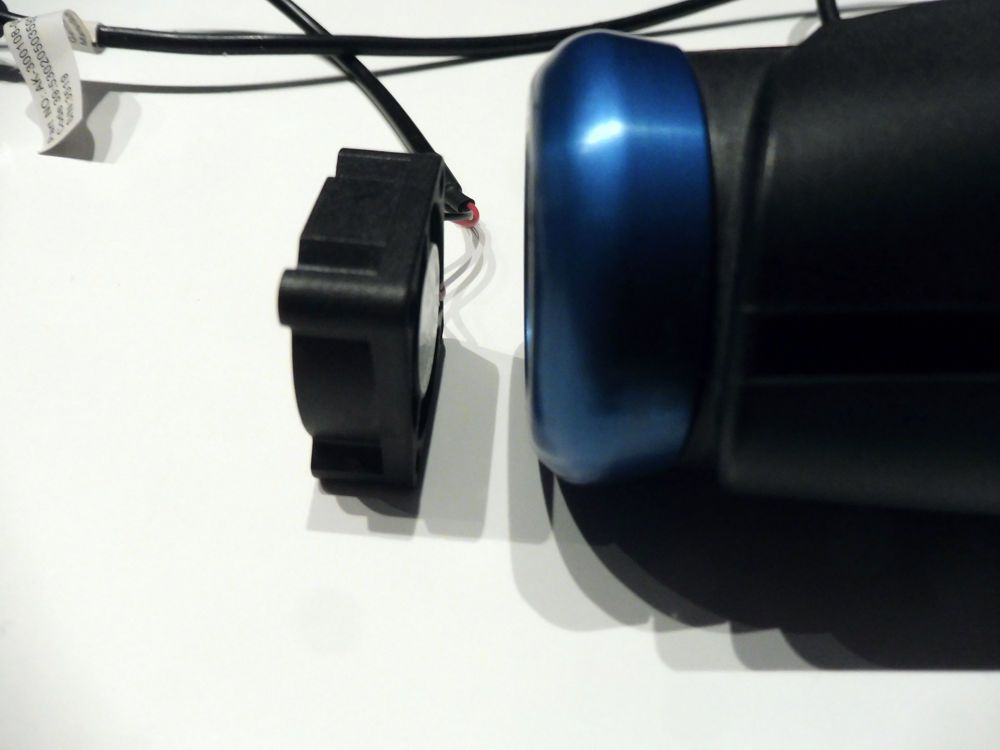
... and this is the overall setup. The Fan has a pass-through for power, so I can run the fan and charge the Sylphyo battery at the same time on the charger and cable provided by Aodyo. The charger cable in this image extends off to the right to plug in to the Sylphyo:
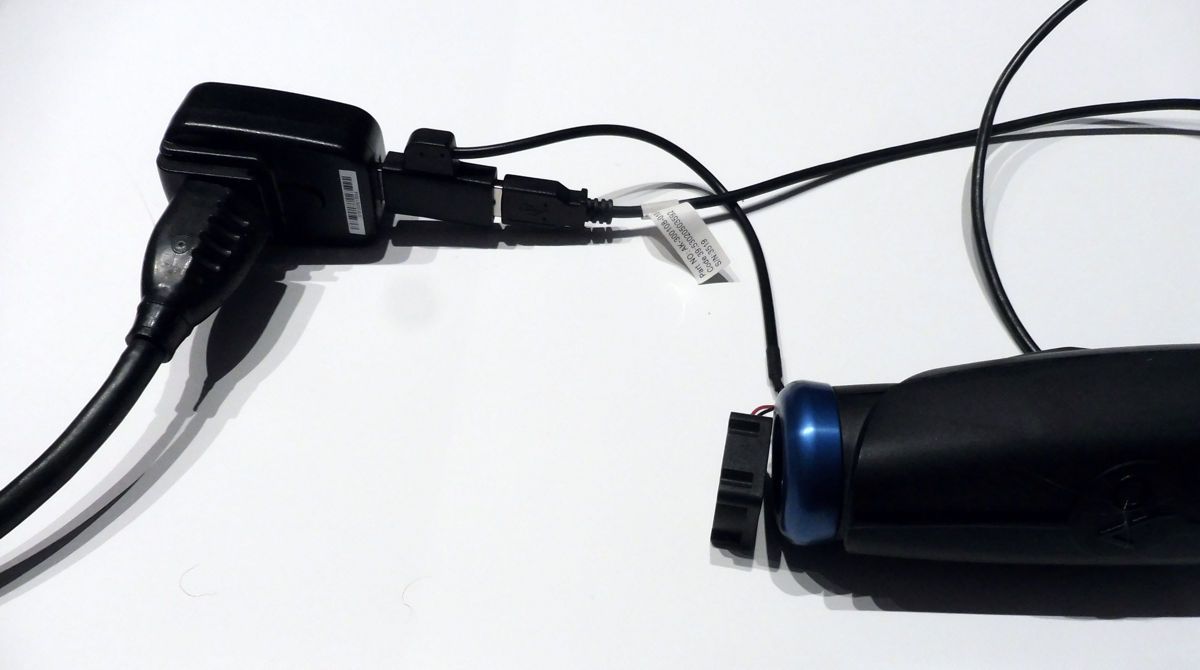
-
RE: Pedro Eustache's Sylphyo Settingsposté dans Sylphyo General
@support_aodyo Excellent insight and info ... Thanks!!
-
Pedro Eustache's Sylphyo Settingsposté dans Sylphyo General
Pedro Eustache posted his Sylphyo settings on the Respiro forum ... it's from a while ago, but some may find it of interest ...
https://www.imoxplus.com/site/index.php/forum/tips-tricks/34-pedro-eustache-s-sylphyo-settings
-
RE: Intensité son casqueposté dans Support
From what I understand, the impedance (Ohm rating) of the headphones is very important for volume. There is an inverse relationship: more impedance (higher Ohm rating) = lower volume. However, more impedance also means better quality sound (for reasons of electrical engineering beyond my understanding).
Most "on the road" earbuds and "consumer" headphones seem to be low impedance, because the sound sources (MP3 players, smartphones, etc) don't have enough current to drive high-impedance headphones to sufficient volume.
The Sennheiser HD 201 of @Fanch35 is rated at 24 ohms ... in the "low impedance" category ... and should be quite loud.
The Ultrasone Pro 900 of @David-Lazzi is rated at 40 ohms, so they should be quieter (maybe twice?) and would require a higher volume setting to get the same level in the ear.
The Presonus HD7 and HD9 are rated at 32 and 40 ohms.
My personal preference are the line of Beyerdynamic headphones. They are ultra-comfortable (for me), have replaceable earpads, and come is a variety of configurations and impedance ratings. My preference is for closed-cell (closed-back) headphones, because I often do overdubs and don't want the sound of the track to bleed into my microphone. (However, that issue is now moot with the Syplhyo!)
I use the DT-770s in the 80 ohm and 250 ohm varieties. On the 250 ohm headphones, about 80-100% volume on the Sylphyo is right for me on Flute Phy # 30.
One concern for me: the strength and durability of the 1/8" headphone connector (and its neighbors, the on-off switch and USB port). My headphones have a spiral-wound chord and do put possibly heavy side-loads on the connector. If anything happens to the connectors in that area, I think it would be a big repair!
-
RE: Not Saving my Changed Settings after power Down-Up (SOLVED BY FACTORY RESET)posté dans Support
@support_aodyo The Factor Reset worked!! I can now store settings and they persist through a power cycle.
Thankfully, I wrote down the myriad settings I have adjusted ...
Thank you SO MUCH for your help!!
-
RE: Not Saving my Changed Settings after power Down-Up (SOLVED BY FACTORY RESET)posté dans Support
@support_aodyo Updating the Sylphyo to the v1.4.8b10 firmware seems to have no effect (although I do see a little "BC" symbol with a wave over it in the lower right of the display, with something that looks like a speaker to the right). I have not updated the firmware on the Link.
BTW this v1.4.8b10 does not have my Native flute fingering updates - the 6 additional fingerings from 25Feb21 ...
-
RE: Not Saving my Changed Settings after power Down-Up (SOLVED BY FACTORY RESET)posté dans Support
@support_aodyo It is only changes that I make. My setup as it existed before this issue began happing have not been affected.
The affected setup changes include Quick Changes made to the three parameters (Base pitch, Sound, and primary MIDI channel) as well as any changes made using the full menu.
My Sylphyo currently has firmware v1.4.8b4. I have the installer for v1.4.8b10, but hesitate to run it because whatever issue is causing the loss of settings might cause havoc during a firmware upgrade.
Have you heard of this happing before?
-
Not Saving my Changed Settings after power Down-Up (SOLVED BY FACTORY RESET)posté dans Support
Not sure what could make this happen ... but ...
Any changes I make to settings on my Sylphyo are lost if I power the Sylphyo down and up with the power switch near the foot of the instrument.
Any advice??
-
RE: Middle Cposté dans Support
Thanks Maxence ... yes, I've got that ... but the "3" in "C3" could mean (as I've found out recently) many different things depending on the octave numbering you use. The Sylphyo (from my examining the MIDI stream it puts out) puts out MIDI hex 3C = decimal 60 for "C3" which is Middle C. That's the same standard that Kontakt, Apple Logic, Cubase, Steinberg, and Yamaha keyboards use.
However, the ISO standard that is used by Korg, Roland, and most of the piano tuning and composing world (and also the Native flute world) use "C4" for Middle C. That's why I was always off by an octave before I understood these issues.
Cakewalk Sonar actually uses C5 for Middle C, which is really confusing!
-
Middle Cposté dans Support
The manual mentions C3 in a number of places, but never mentions that the Sylphyo uses C3 = Middle C (the Apple and Yamaha standard) rather than the ISO C4=Middle C standard (or Sonar which uses C5!).
This was actually a head-scratcher for a few minutes, until I saw the MIDI stream and realized C3 was producing MIDI note 60.
-
RE: Differents CCs with differents curves from the breath...posté dans Sylphyo General
Hello @jcfitn ! ... interesting idea ...
If I understand your intent, I think that is achievable without modifying the Sylphyo. I use Cantabile to route the Sylphyo MIDI stream to many different places (software and hardware). It is designed to split the MIDI stream to may routes that go to many targets, and also apply complex filtering (curves, minimum, maximum and many more possibilities). There is a free version of Cantabile which has quite a lot of features ...
Alternately, the Sylphyo can transmit CC messages from the breath sensor on up to 3 MIDI CC channels simultaneously.
-
RE: Floor Standposté dans Sylphyo General
I just posted a "Cradle" on Thingiverse: https://www.thingiverse.com/thing:4801206 ... be sure to add felt pads (or some other protection) on the contact points with the Sylphyo:
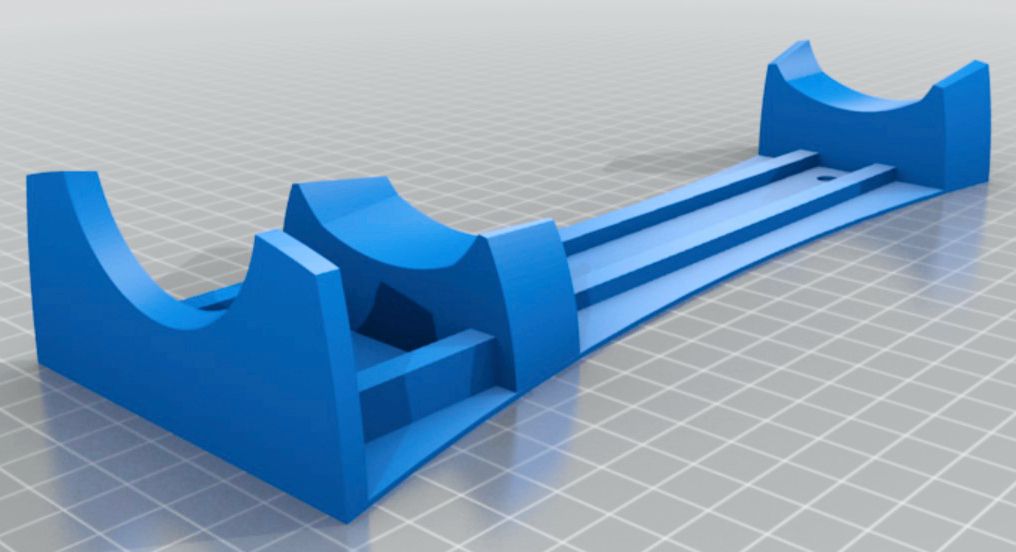
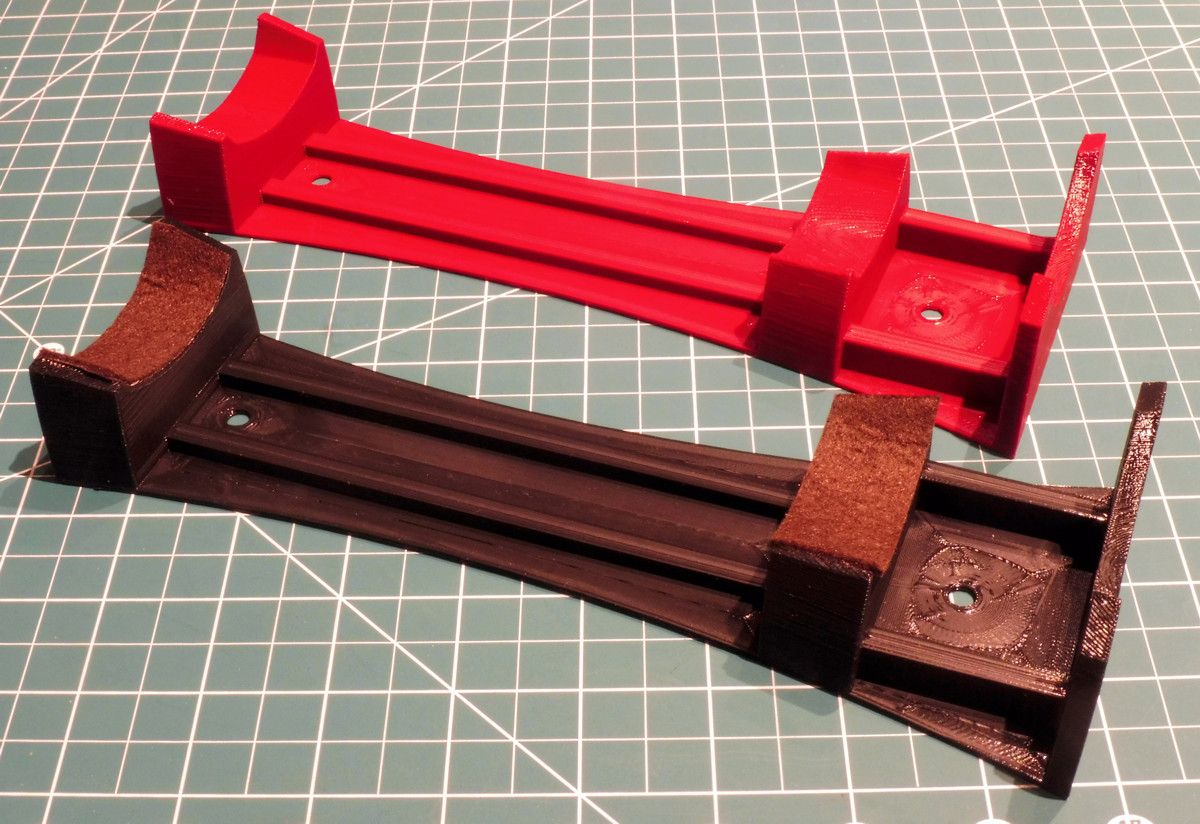

-
RE: Blocking the Bell Portposté dans Sylphyo General
@badblocks I would love to hear details on how other materials work with this part!
I am thinking that flexibility is a key issue. PLA is rather strong but not very tolerant of deflection - it tends to snap suddenly and with sharp edges. Something with a bit more give would be ideal ... maybe ABS? (I don't print in ABS because I don't have a good ventilation setup) ...
-
RE: Blocking the Bell Portposté dans Sylphyo General
@David-Lazzi I realize that 3D printers are not yet mainstream enough for easy access for everyone. I wish we were able to produce and ship these plugs, but we are not really set up for that. One daunting issue is that many players are on the Continent and shipping to Europe for us is complex (forms and then more forms).
I have sent several samples of each of the three largest sized plugs to @Maxence822. I also believe that Aodyo is working on their own design. I am hoping that Aodyo will adopt a strategy for providing whatever turns out the be the best plugs to the community ...
-
RE: Blocking the Bell Portposté dans Sylphyo General
@David-Lazzi I was doing pretty well with tape, but the back pressure varied every time I played (annoying), it sometimes gave way a bit and the back pressure would change, and it was mildly "unprofessional".
3D printing is easy for me, and if you have easy access to printing the parts I posted on Thingiverse, it might be worthwhile. However, I suspect the rolled-up tubing works just as well.
-
RE: Blocking the Bell Portposté dans Sylphyo General
@badblocks I have just uploaded three more STL model files with more restrictive air channels ... https://www.thingiverse.com/thing:4768549 ... Please tell me how they work out.
The largest of my plugs should (based on the cross sectional area of the air channel) increase back pressure by a factor of 2.3, the smallest of my plugs (that I just uploaded) should increase back pressure by a factor of 6.7.
CAVEAT: I have not printed these ... but I expect they should work ...
-
RE: Blocking the Bell Portposté dans Sylphyo General
@David-Lazzi Sadly, I am flutter-tongue-challenged**, so I can't test that.
On my instruments (mostly Native American flutes) my approach to growling is to hum. However, unlike the way sax players growl, I typically hum the same notes as I am playing. (It's easy - essentially a "sing what you play" exercise.)
On real-world Native flutes, prominent humming produces an "effect" that you might use only occasionally. However, very quiet / slight humming can be used more generally to control the timbre of my sound.
On real-world flutes, I suspect that the humming vibration cross-breeds with the resonant air column vibration in the flute's sound chamber to produce a complex vibe-child. For reed instruments, maybe the mechanism is different ... maybe it alters the way the reed responds??
On wind controllers with pressure sensors, I imagine that the sensor is rapidly responding to pressure changes and sending those changes at whatever rate the singles are configured (and certainly capped by the 31.25 kHz MIDI bitrate).***
It seems to me that the sound you get is based on how your sound generator responds to that stream of breath changes.
My setup parameters are:
- MIDI Mapping => Breath => Breath Rate = Medium (250Hz)
- Breath => Curve = Log
- Breath => Filtering => On
- (not sure what other parameters are relevant)
... and I have not (yet) tried any other settings
My experience with those setting on sampled-based virtual instruments (I'm mostly using Kontakt instruments I've recorded and constructed using Unisono - Portamento) humming does not work well. I get a stuttering effect that is not particularly useful (to me).
On physical modelling engines such as Respiro, the results seem to be much more useful. Of course, Respiro is not modelling real-world instruments but instruments that really are virtual, so there is no set standard. But to me, some of those instruments do produce effects with humming that do seem cool!
** I have a "tied tongue" - a connection on the bottom of my tongue to the floor of my mouth that prevents me from flutter tonguing. It is a tradition at our workshops that our student will flutter tongue at every opportunity as a joke.
*** Does the 31.25 kHz MIDI Baud rate also apply to MIDI over USB?? I can't find a source that addresses this ...
-
RE: Blocking the Bell Portposté dans Sylphyo General
@badblocks Thanks for the feedback!
Wow ... so you prefer the most restrictive one? The one with the most back-pressure?
I just want to confirm ... and, if so, I can easily produce even more restrictive plugs ...
-
RE: Octave issuesposté dans Support
I have tried rather persistently to make this happen, and I have not been able to. My firmware is v1.4.8b4, so that may be a difference.
I experimented using 5+2 mode both with a fingering that defines pitches for the thumb pad open (the new "Native American Flute+" fingering) as well a one which has "don't care" for the thumb pad (Recorder). Both resulted in the same ... I could not get any notes to stick.
I was working with only the top pad on the front side of the six main pads closed. That is the failure mode, correct?